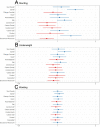Undernutrition in children aged 0-59 months by region and over time: secondary analysis of the Burkina Faso 2012-2018 National Nutrition Surveys
- PMID: 37673454
- PMCID: PMC10496659
- DOI: 10.1136/bmjopen-2022-066509
Undernutrition in children aged 0-59 months by region and over time: secondary analysis of the Burkina Faso 2012-2018 National Nutrition Surveys
Abstract
The global burden of undernutrition remains high, responsible for significant under-five mortality in resource-limited settings. Numerous sustainable development goals (SDGs) are linked to nutrition, and nationally representative nutrition surveillance is a key activity to track progress towards SDGs and guide efficient programmes.
Objectives: The aim of this study is to look at spatial and temporal trends in undernutrition in children under 5 years age in Burkina Faso.
Setting: We used data from annual National Nutrition Surveys using Standardised Monitoring and Assessment of Relief and Transitions methodology (anthropometry, morbidity) over 7 years (2012-2018) in Burkina Faso.
Participants: Children of under 5 years from households selected through systemic sampling at countrywide level.
Main outcome measures: Prevalence of stunting (height-for-age z-score, <-2), underweight (weight-for-age z-score, <-2) and wasting (weight-for-height z-score, <-2) at regional and national. We used general linear mixed models, adjusted by age, survey year, sex, presence of fever and/or diarrhoea, and poverty index to quantify the risk of undernutrition over time and by region of residence.
Results: Between 2012 and 2018, decreases were observed overall in the prevalence of growth retardation (stunting) decreased from 33.0% (95% CI 32.3 to 33.8) in 2012 to 26.7% (95% CI 26.2 to 27.3) in 2018. Underweight reduced from 24.4% (95% CI 23.7 to 25.1) to 18.7% (95% CI 18.2 to 19.2) for the same period and wasting decreased from 10.8% (95% CI 10.3 to 11.3) in 2012 to 8.4% (95% CI 8.1 to 8.8) in 2018. However, there was substantial variation across the country, with increased risk of undernutrition in the regions of Sahel, East and Cascades primarily. High-risk regions were characterised by a lower poverty index and limited access to healthcare services.
Conclusions: Our findings could inform national policymakers in refining and optimising resource allocation based on the identification of high-risk areas.
Keywords: epidemiology; nutrition & dietetics; public health.
© Author(s) (or their employer(s)) 2023. Re-use permitted under CC BY. Published by BMJ.
Conflict of interest statement
Competing interests: None declared.
Figures
References
-
- FAO, IFAD, UNICEF, and WFP . The state of food security and nutrition in the world 2021. transforming food systems for food security, improved nutrition and affordable healthy diets for all, Rome. 2021.
-
- Development Initiatives . The burden of malnutrition - global nutrition report, Bristol. 2018.
-
- Myatt M, Khara T, Schoenbuchner S, et al. . Children who are both wasted and stunted are also Underweight and have a high risk of death: A descriptive epidemiology of multiple Anthropometric deficits using data from 51 countries. Arch Public Health 2018;76:28. 10.1186/s13690-018-0277-1 - DOI - PMC - PubMed
-
- UNICEF / WHO / World Bank Group . UNICEF-WHO-the world bank: joint child malnutrition estimates – levels and trends – 2021 edition - UNICEF DATA. 2021.
-
- Brown M, Backer D, Billing T, et al. . Children: improving survival and well-being. Food Secur 2020;12:1241–52. 10.1007/s12571-020-01041-y - DOI
Publication types
MeSH terms
Grants and funding
LinkOut - more resources
Full Text Sources
Medical


